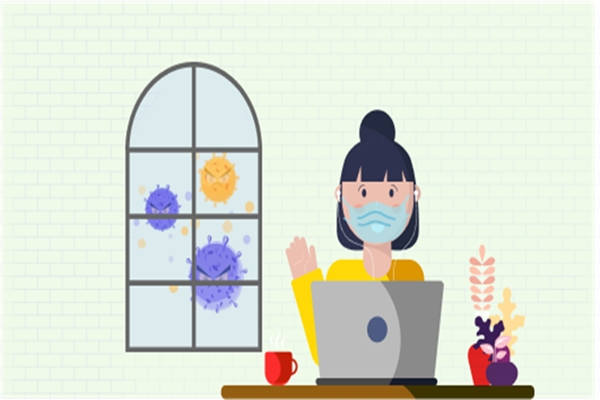Work From Home may not entirely ease things for employees since such a setting often expects employees to remain 'connected to the system'. And the traditional perception of work will turn out to be equally precarious.
These days, while scrolling networking platforms, it is inevitable to come across posts about how the present health crisis is leading us to the new future of work or how this has come about as the ‘new normal’. Most of the influencers build on the fact that Work From Home (WFH) is a moment of solace for individuals to catch up on their hobbies, upskill themselves, or even learn a new craft. However, if this emerges as the new normal, things would collectively not come about as highly bright. We are treading the precarious line of converting work into labour.
Labour consists of all the activities carried out by individuals as a part of their daily routine. Sayers (2007), in his paper, ‘The Concept of Labor: Marx and his Critics’, mentions that labour is the direct appropriation of human beings’ natural condition. Hannah Arendt, in her famous book, The Human Condition, defined labour as “...the activity which corresponds to the biological process of the human body, whose spontaneous growth, metabolism and eventual decay are bound to the vital necessities produced and fed into the life process …”
Whereas the concept of work is assessed merely on the grounds of performance, and once work shifts home, the usual innate activity of individuals such as care and home support is merged with their existing work activity. And, to derive a balance among the two would be a challenging task for individuals, as ‘work’ includes measurement. Hence, it is no surprise that even when people are working from their homes, there is an overt sense to be hyperproductive and of achievement.
In all this, digital technology plays the vital role of wiring human beings to their work and organisation. In such a wired environment, employees sitting at home must operate like digital natives. Digital natives across the world curate their lives and leave digital traces across different digital platforms such as Zoom, LinkedIn, Instagram, Twitter among others. The courses they undergo, the people they mentor, their writeup trends and the causes they believe in are all digitally achieved.
Surely, WFH would formally be a part of HR policies. However, the work lives of individuals, especially women employees, are bound to be hectic with the stress of logging into their respective platforms vis-à-vis caring and supporting their families. WFH arrangements may further glamourise hustle-based culture which seems to have become an institutional norm in the digital universe.
In such a context, enterprise-led WFH may lead to employee burnout. As in the realm of work labour, the personal-professional would be bound to have a similar spatial setup, with employees navigating their home chores along with meeting their professional deadlines. While we cherish every moment to be at home with our loved ones, WFH may not entirely ease things for employees, as such a setting often expects employees to be ‘connected to the system’. The traditional perception of work, if replicated in the digital universe, will be equally precarious.
Do you think hybrid work arrangements would be a common feature of the workplaces going forward?
Trending
-
SBI General Insurance Launches Digital Health Campaign
-
CredR Rolls Out 'Life Happens' Leave For Its Employees
-
Meesho Announces 30-Week Gender-Neutral Parental Leave Policy
-
Microsoft Unveils Tech Resilience Curriculum To Foster An Inclusive Future
-
60% Indian Professionals Looking For Job Change Due To COVID: Survey
-
SpringPeople And Siemens Collaborate For Digital Transformation Push
-
86% Professionals Believe Hybrid Work Is Essential For Work Life Balance: Report
-
Almost 1 In Every 3 People's Personal Life Affected Due To Work Stress
-
Meesho Rolls Out Reset And Recharge Policy For Employees
-
80% Of Talent Leaders & Academics Say Pandemic Changed Skill Needs For Youth: Report
-
Hero Electric Rolls Out 'Hero Care' Program For Employees
-
Human Capital In Collaboration With ASSOCHAM Hosts Virtual Conference
-
IKEA India, Tata STRIVE Collaborate To Create Employability And Entrepreneurship Opportunities
-
SAP India, Microsoft Launch Tech Skilling Program for Young Women
-
DXC Technology, NASSCOM Collaborate For Employability Skills Program
-
Lenskart To Hire Over 2000 Employees Across India By 2022
-
Mindtree Launches Learn-and-Earn Program
-
Tata AIA Extends 'Raksha Ka Teeka' To Its Employees
-
Swadesh Behera Is The New CPO Of Titan
-
NetConnect Global Plans To Recruit 5000 Tech Professionals In India
-
Hubhopper Plans To Hire 60% Of Indian Podcasters By 2022
-
Corporate India Needs More Women In Leadership Roles: Report
-
Aon to Invest $30 Million and Create 10,000 Apprenticeships by 2030
-
Tech Mahindra Launches ‘Gift a Career’ Initiative for Upskilling of Youth
-
40% Women Prefer Flexible Working Options in Post-COVID World: Survey
-
3 out of 4 companies believe they can effectively hire employees virtually: Report
-
Vodafone , CGI and NASSCOM Foundation launch digital skills platform
-
Odisha: Bank, postal employees to deliver cash for elderly, differently-abled persons
-
Skill India launches AI-based digital platform for "Skilled Workforce"
-
Hiring activity declines 6.73% in first quarter: Survey
-
70% startups impacted by COVID-19 pandemic
-
Bajaj Allianz Life ropes in Santanu Banerjee as CHRO
-
Over 70 Percent MSMEs look at cutting jobs to sustain businesses
-
93 Per Cent employees stressed about returning to office post-lockdown
-
Johnson & Johnson India announces family benefits for same gender partners
-
Indian firms turning friendly towards working mothers
-
Welspun India names Rajendra Mehta as new CHRO
-
Wipro partners with NASSCOM to launch Future Skills platform



Human Capital is niche media organisation for HR and Corporate. Our aim is to create an outstanding user experience for all our clients, readers, employers and employees through inspiring, industry-leading content pieces in the form of case studies, analysis, expert reports, authored articles and blogs. We cover topics such as talent acquisition, learning and development, diversity and inclusion, leadership, compensation, recruitment and many more.
Subscribe Now













































Comment